Megan Rapinoe: ‘We just didn’t have that juice that we normally do’
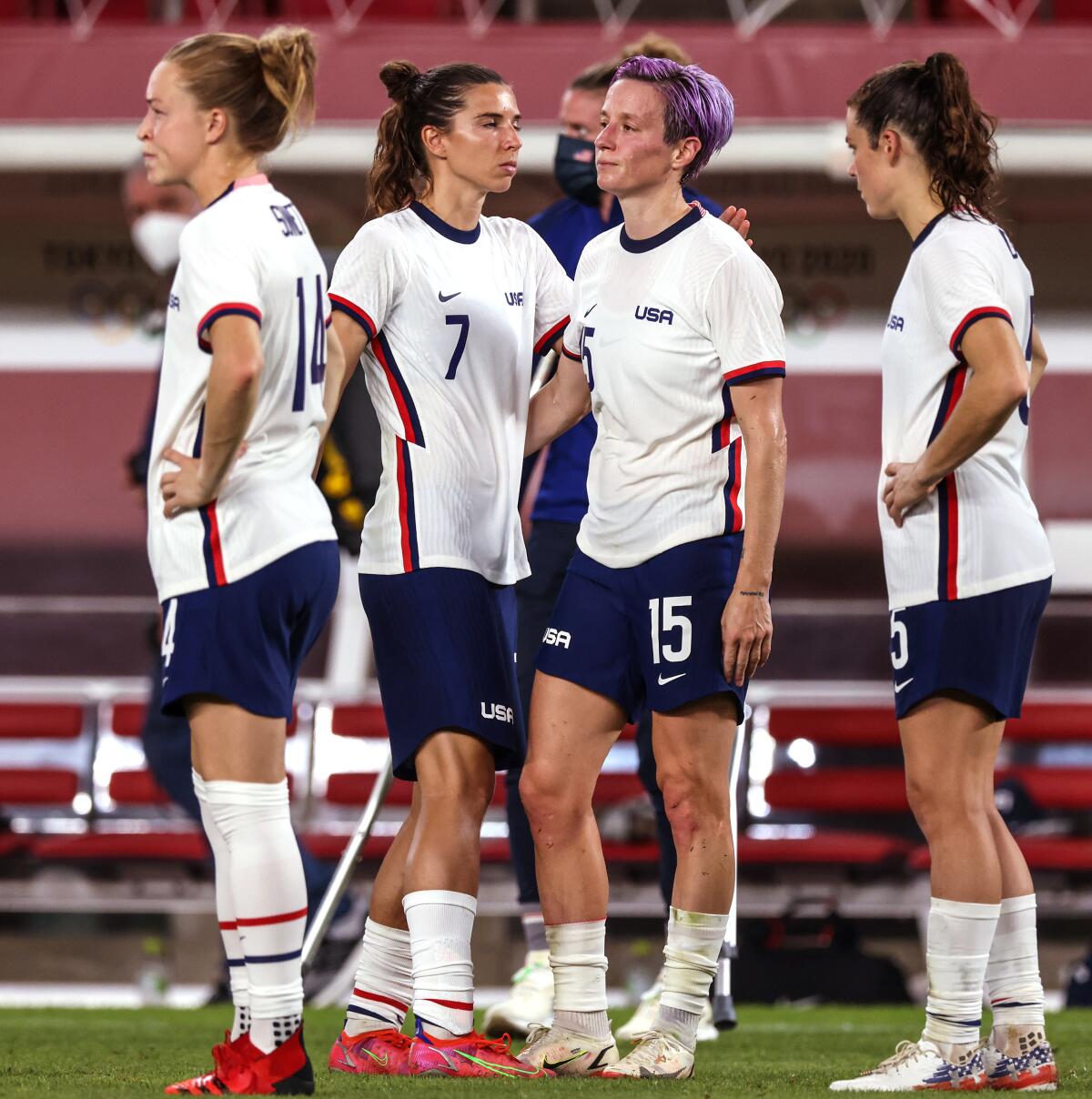
- Share via
Hello and welcome to the L.A. Times soccer newsletter. I’m Kevin Baxter, The Times’ soccer writer, coming to you a little later than usual from the steam bath that is Kashima, Japan, about 70 miles — and a few hundred degrees — west of Tokyo.
Kashima, which translates as Deer Island, is home to the Antlers, a J1 team founded in the wake of World War II. I’ve made the four-hour round trip from Tokyo twice in the past two days, first to watch Canada knock the U.S. women out of contention for an Olympic gold medal, then to see Brazil do the same to Mexico’s men.
Both games were decided on penalty kicks, the U.S. falling on Jessie Fleming’s PK in the 74th minute after a questionable foul on Tierna Davidson and Mexico going down in a PK shootout after 120 scoreless minutes.
The U.S. women’s loss felt transformational; even Carli Lloyd called it “the end of an era.” And it probably was.
Eleven players on the roster are on the north side of 30. And though 17 women on the Olympic team also played in the last Women’s World Cup in 2019, the difference in how they played in the two tournaments was striking.
The U.S. never trailed in France, rolling to their second straight championship. In Japan they rarely led, were shut out three times in five games and looked every bit their age. The U.S. made the final in the first six women’s Olympic soccer tournaments, winning the title five times.
But they haven’t played for the gold medal since 2012. And after the loss to Canada — the first since March 2021 — players struggled for an explanation. Some quietly criticized coach Vlakto Andonovski’s rotation system, which was actually a necessary remedy for an aging team that played every three days in the heat and humidity of the Japanese summer.
“It hasn’t flowed for us. it hasn’t been easy,” Megan Rapinoe said. “It’s not for lack of effort. It just didn’t click for us. I don’t know if it’s roster rotation but our roster’s deep as hell. We just didn’t have that juice that we normally do.
“Not even close to our best performances that I’ve seen over the years or even under Vlatko this year. We didn’t expect it to be easy. It’s all the best teams in the world and everything’s on the line. We couldn’t unlock it.”
The women’s national team has never lacked for its divas, but the criticism of Andonovski, which will increase sharply if the U.S. doesn’t dominate Thursday’s bronze-medal game, feels cheap. The coach was unbeaten in his first 23 games and came to Tokyo with his team riding a 44-game unbeaten streak.
He was John Wooden in cleats, and the players praised him.
Until they didn’t.
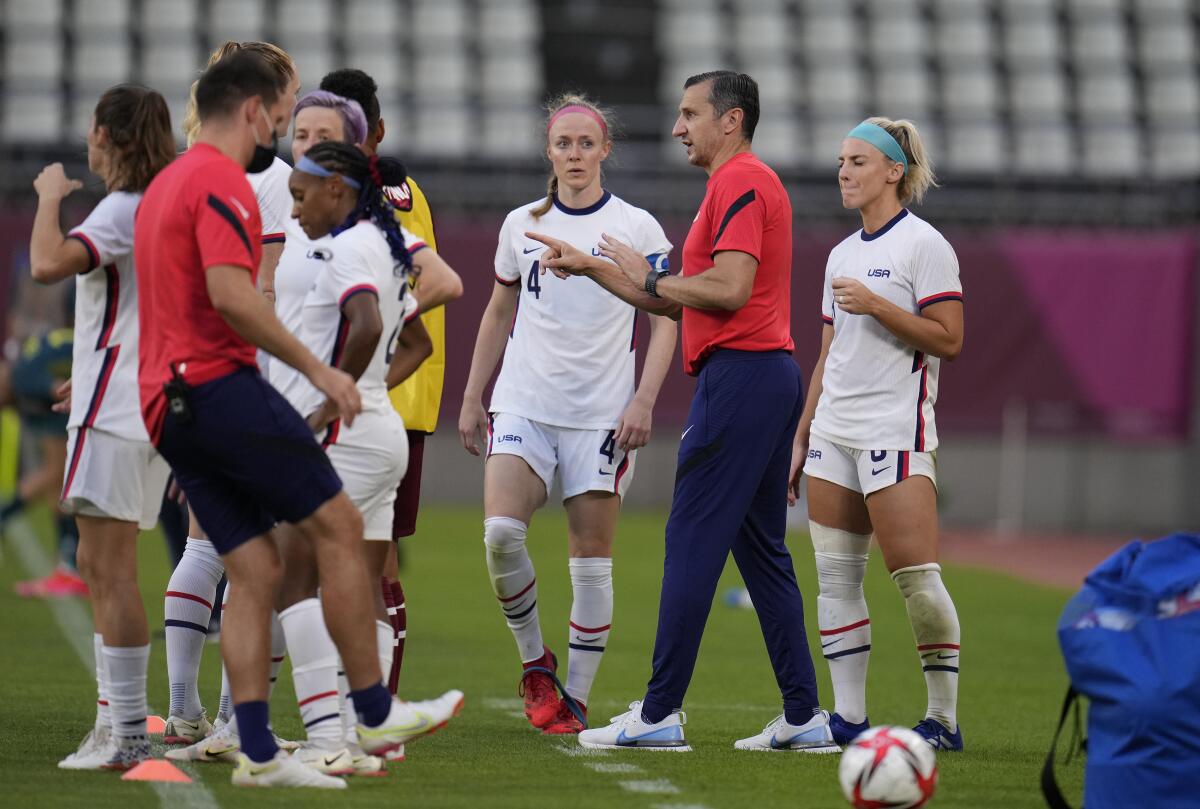
Sure he made some bad moves in Japan, chief among them playing for a draw with Australia. But he didn’t make one bad pass, cost his team any goals by being offside nor lose his mark on a set piece. His players did all of that. Repeatedly.
The team relied too heavily on imprecise crosses and shots from distance rather than dribbling at defenders to create better chances. There was little of the creativity, magic and desire that defined the 2019 team. The U.S. had simply lost its mojo.
And while the rotation may have contributed to that, it was something Andonovski had talked about before Japan; it wasn’t a surprise. And it was clearly the only way he could get his geriatric group through the tournament.
Consider that Lloyd turned 39 in Japan; Becky Sauerbrunn is 36. Kelley O’Hara will turn 33 the day before the third-place game with Australia. Alex Morgan and Christen Press are both 32; Tobin Heath’s a year older. With the exception of occasional flashes of brilliance from Press and Heath, none resembled the players they were in France.
Lloyd perhaps came closest to offering an explanation that didn’t sound like an excuse.
“This whole tournament has not been right,” she said. “No fans. Can’t leave the hotel. Stand 10 feet from [the media]. “
But, she added “everybody’s in the same boat.” And the others in the boat adapted. The U.S. didn’t and now the transition to a new team begins.
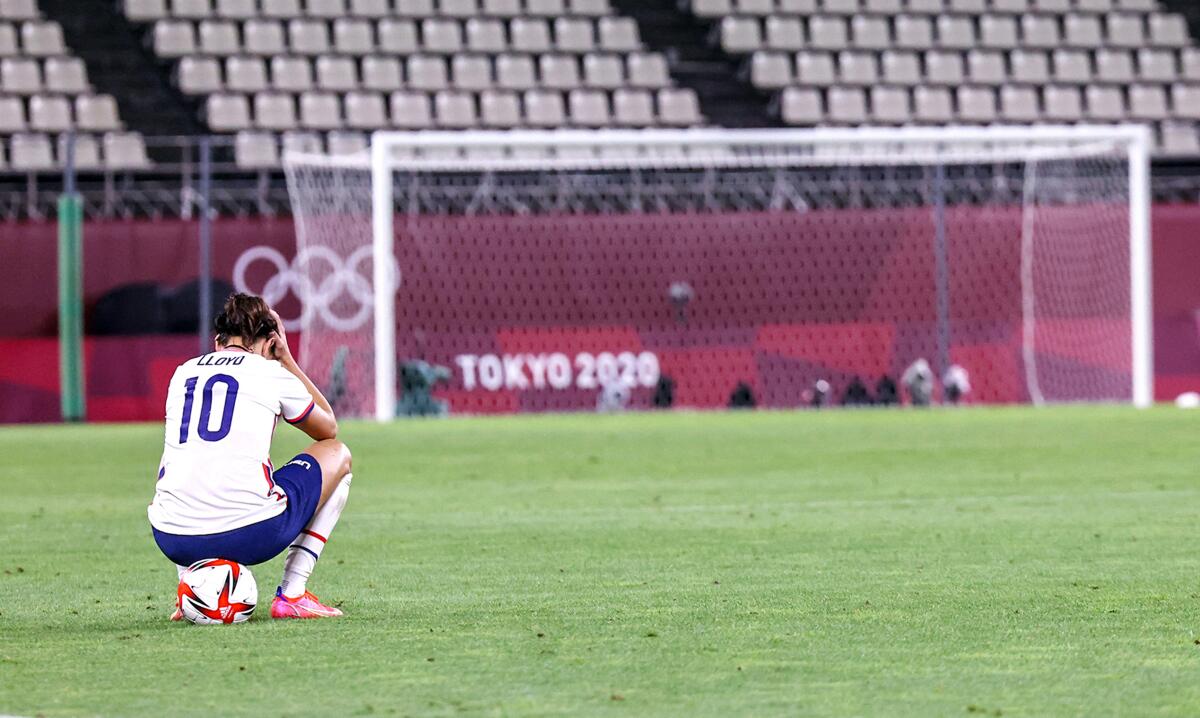
The women’s national team hasn’t really been an unbroken dynasty so much as it’s been a series of golden generations, each one passing the baton to the next.
In 2004, Mia Hamm, Julie Foudy and Brandi Chastain retired after winning two World Cups and two Olympics, turning the team over to Abby Wambach and, later, Hope Solo. Wambach played her final game in 2015, Solo seven months later. By then the team already belonged to Lloyd, Morgan, Rapinoe and Sauerbrunn.
Now comes another handoff because it’s unlikely the core of the 2019 World Cup team makes it to the 2023 tournament in Australia-New Zealand. So who will step up to receive the baton? Rose Lavelle? Lynn Williams? Catarina Macario? Lindsey Horan? All of them? None of them?
And will Andonovski be around long enough the supervise the handoff or will the long knives take him down first?
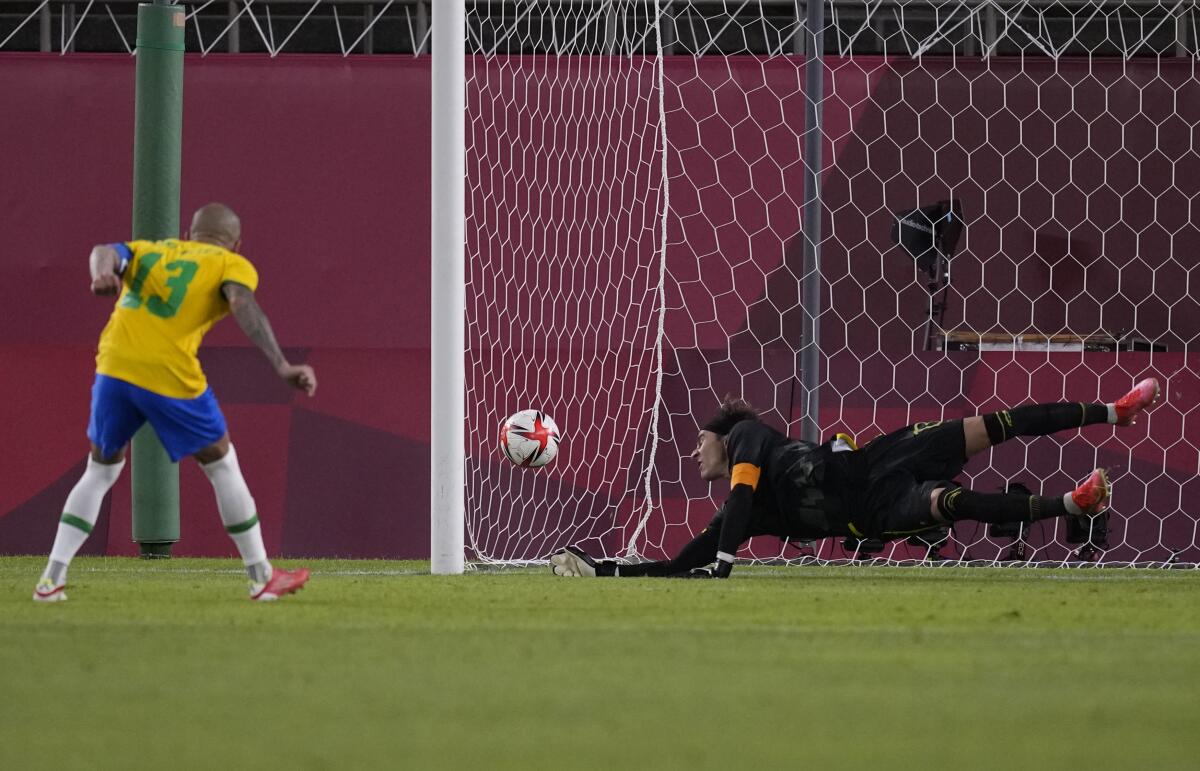
As for Mexico’s U-24 team, Brazil dominated by large margins in possession, shots and just about anything else you want to measure. They simply played better. But Mexico arguably played tougher, fighting through 120 minutes in steamy conditions only to lose on penalty kicks when goalkeeper Guillermo Ochoa, one the team’s three overage players, failed to make a save.
(Sharing the blame are Mexico’s outfielder players, who didn’t score a goal in 120 minutes and then missed two of their tries in the shootout.)
As a result, Brazil will play in its third straight Olympic final, this time against Spain, while Mexico will face Japan in the bronze-medal game.
“Obviously it hurts. It’s going to be tough, honestly, to sleep tonight,” Mexican coach Jaime Lozano said Tuesday.
But that was as much pity as he allowed himself and his players.
“I told them when we came off the field how proud I am of them. And in three days we still have a shot at taking home a medal,” he said. “It’s important not to overlook that.
“This is my first time here and what I think I’ve understood from being here is just how hard it is to take home the gold. The Olympics is an incredible sacrifice. It requires so much more than a few weeks or months of training. And so coming out in [the top] four places means that you’re among the very best.”
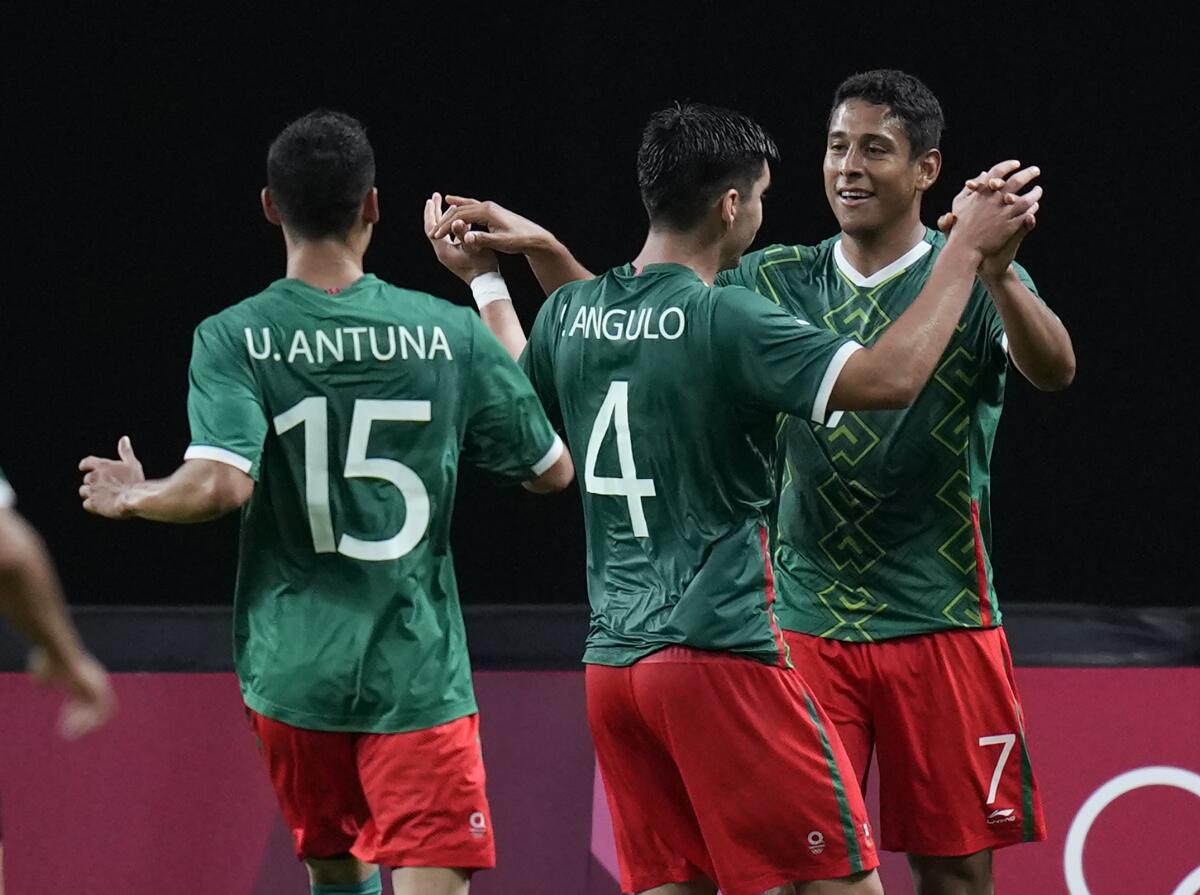
There’s more reason to feel good about Mexico’s performance, starting with the fact that Friday’s appearance in the third-place game will mark just the second time the country has played for an Olympic medal in men’s soccer. The first time was in 2012, when it beat Brazil in the final. That tournament helped launch the senior national team careers of Héctor Herrera, Raúl Jiménez, Néstor Araujo and Diego Reyes.
Lozano expects the attention and experience his players got in the Tokyo Games will do the same thing for the likes of Uriel Antuna, Sebastian Cordova, Diego Lainez and Alexis Vega.
“That’s exactly what I want,” he said. “What I want most is for the majority of our players, the overwhelming majority, to make it to Europe, to play in good clubs, to play at the elite level.”
“Those leagues play with an intensity that isn’t seen elsewhere. And we need more of our Mexican players to be surrounded by that environment,” added Lozano whose team, with the exception of Lainez, is domestically based. “If not, we’re not able to get more Mexican players in the European leagues, then perhaps we’ll not dominate as much as a national team. So obviously, yes, that is something that I’m really hoping we’re able to achieve in the future.”
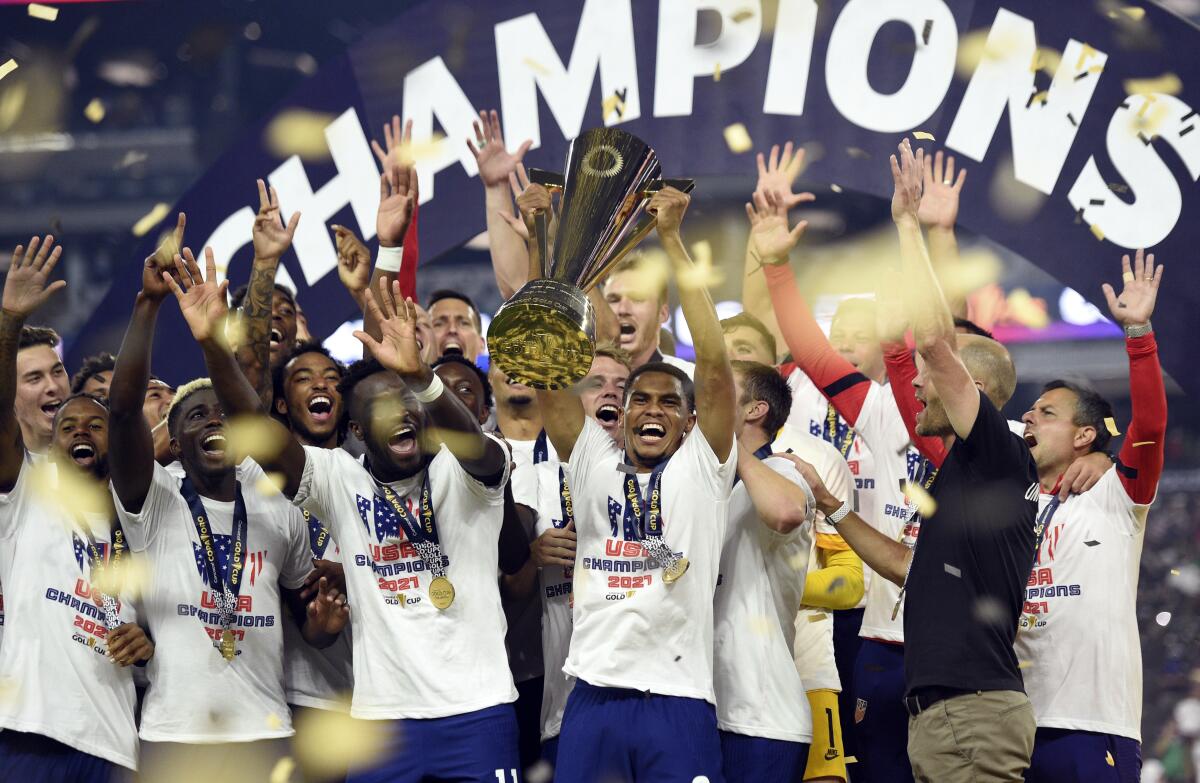
A passing of the CONCACAF torch?
Speaking of Mexican not dominating in the future, the U.S. and its rival to the south have met twice this summer, in the final of the Nations League in June and in the CONCACAF Gold Cup on Sunday, with the U.S. winning both games in extra time.
That’s significant for a number of reasons, not the least of which is the fact it’s the first time the U.S. has beaten Mexico in consecutive games since 2002.
It’s also significant because it gives the U.S. both confederation titles, unseating Mexico, which won the last Gold Cup. And finally, it’s significant because it may mark a changing of the guard. We’ll know more about that when the teams meet again in November in Cincinnati in a World Cup qualifier.
What we know now is the U.S. won the Gold Cup with a “B” team, one missing the core of its European base. In its place was a roster comprising mainly MLS players — some of whom significantly raised their profile in the tournament and now are in the picture for the team’s eight qualifiers this fall.
At the top of that list is New England Revolution goalkeeper Matt Turner, who was brilliant against Mexico, making five saves for his fifth shutout of the tournament. Turner, chosen the outstanding ’keeper in the competition, allowed just one goal — on a penalty kick — and finished the Gold Cup with 416 consecutive scoreless minutes.
Atlanta United center back Miles Robinson, who scored the only goal in the final with three minutes to play in the second extra-time period, also forced himself into the conversation going forward. Kellyn Acosta and former Galaxy striker Gyasi Zardes played well, too.
It wasn’t a cakewalk — the U.S. won five of its six games, including the final, by just a goal. And in the last three, the winning score came in the 83rd minute or after. But the Americans got the job done.
If the U.S. is ascending and widening its talent pool, Mexico is heading in the other direction. While the core of Gregg Berhalter’s first-choice U.S. team remained in Europe with their clubs, Mexican coach Tata Martino’s roster primarily is domestically based, which gave him access to most of the players he wanted — with some notable exceptions.
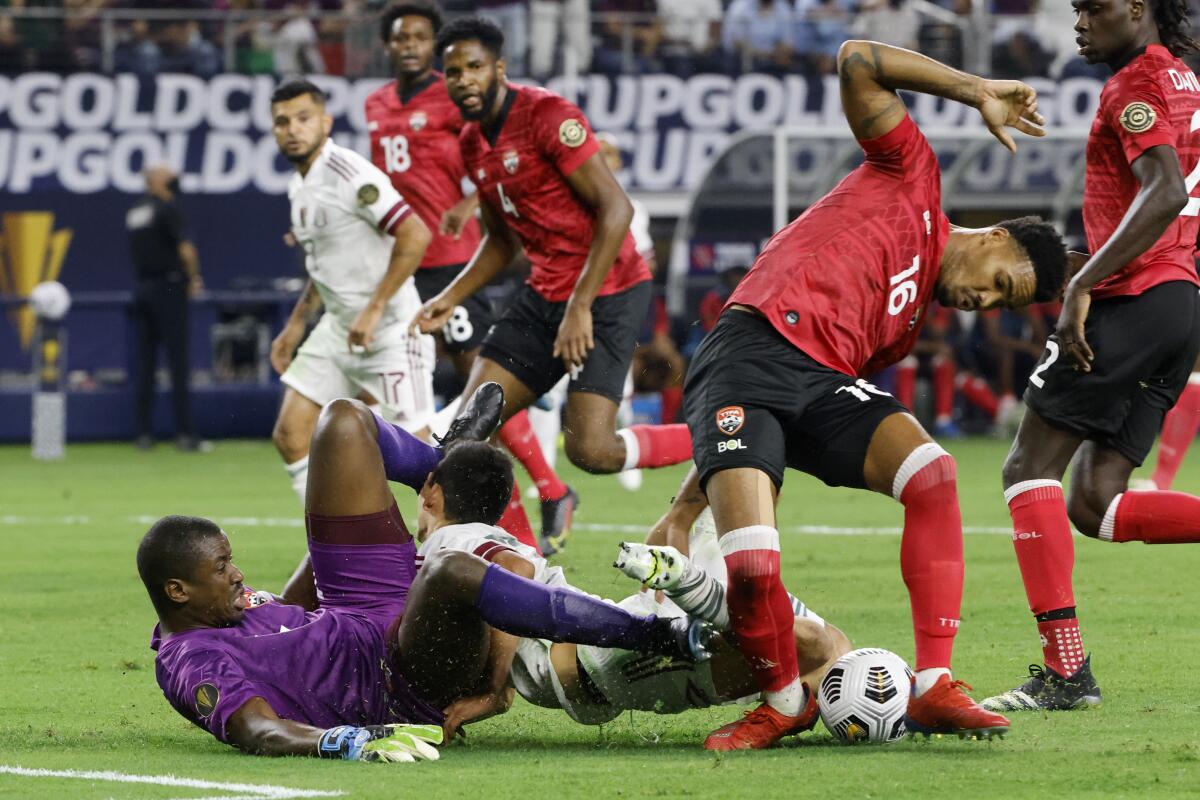
Hirving Lozano, El Tri’s top offensive threat, was injured early in the tournament opener and may not return in time for the first qualifiers in September. Also absent were forward Henry Martín and Ochoa, both of whom are playing for Mexico’s U-24 team in the Tokyo Olympics; Raúl Jiménez, who still is on the mend from a severe head injury and ageless midfielder Andrés Guardado.
They were missed. Mexico was shut out twice in the tournament and has failed to score four times in its last 12 games. More important, however, is the fact Mexico is getting old and the U.S. isn’t, which is why Sunday’s result feels like a portent of something bigger.
Mexico had the second-oldest team in the 2018 World Cup, a tournament the U.S. didn’t qualify for. The Americans used that disaster to its advantage, with coaches Dave Sarachan and Berhalter giving 64 players their first senior national team caps in the last 3½ years, overturning the roster. Mexico stayed the course and got older.
The results of both those decisions were on display Sunday in Las Vegas: Mexico’s starters averaged 29.5 years old and included six players on the wrong side of 30 while the lineup the U.S. used was five years younger. The only time the U.S. started a younger 11 in a tournament final was in June’s Nations League final, when it also beat Mexico.
And the young Americans weren’t intimidated by their seasoned rivals in going toe to toe with the physical Mexicans in a game that saw 51 fouls called, including 31 on the U.S. The U.S. also blocked seven shots. Martino, who lost twice in his first 25 matches with Mexico, has lost two of his last 10, both to the U.S. So the momentum is on the side of the young Americans, who won nine in a row and 15 consecutive games against CONCACAF foes.
Bigger tests lie ahead, though. Beating the likes of Mexico, Honduras, El Salvador and Costa Rica at home is one thing, but playing on the road in CONCACAF is something many of these young players have only heard about.
“The only way you can get comfortable in that environment is experience with it,” said Landon Donovan, who played in 40 World Cup qualifiers, behind only Clint Dempsey and Jozy Altidore among Americans. “There’s no simulation for going to Barbados, on a tiny little island, playing on a horrible field, 95-degree weather with 90% humidity other than doing it and feeling the pressure involved.
“We don’t have enough guys right now who have been through enough of those experiences.”
Mexico does, which could make for an interesting qualifying tournament, one which matches the talented if green Americans against the aging but experienced Mexicans.
We’ll have to wait until the final game of that tournament to know for sure whether the cloak of CONCACAF supremacy has been passed on or whether it remains tentatively in Mexico’s hands.
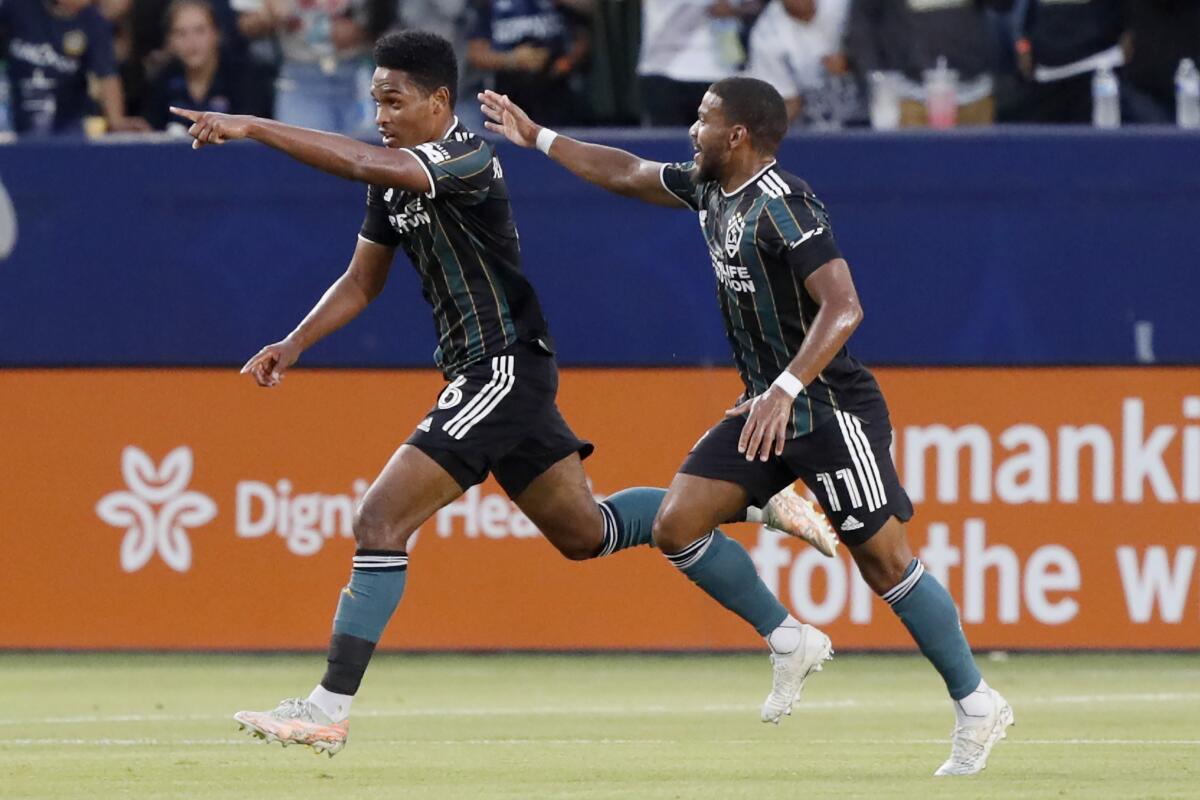
LAFC, Galaxy continue jogging in place
The MLS season will reach the halfway mark for the Galaxy and LAFC this week, but both teams appear to still be searching for an identity.
Consider the Galaxy: they pummeled Portland 4-1 last week, six days after being pummeled 4-0 by FC Dallas. Four months into the schedule, it remains a team in transition.
Through the first three months, the Galaxy’s attack went through Javier “Chicharito” Hernández, who led the league with 10 goals. But since he went to the sidelines with a calf strain Rayan Raveloson, a defensive player, has taken over and scored four times in six games.
In MLS, only Carlos Vela, LAFC’s former Golden Boot winner, has scored as often since Raveloson’s July 4 debut.
Hernández’s return remains uncertain; a strain in the same calf cost him two months last season. But reinforcements are on the way with Sebastian Lletget, Jonathan dos Santos and Efraín Álvarez back from international duty and the team nearing an announcement on the acquisition of Serbian striker Dejan Joveljić, who can either complement Hernández up front or take his place until he returns.
Then there’s the defense. Goalkeeper Jonathan Bond, who gave up three goals in all of June, conceded nearly twice that many in his last two games and has allowed 27 on the season. No Western Conference team has given up more, although Bond has as an excuse in the Galaxy’s still-evolving back line which has seen eight players appear in a game this season.
Yet despite all that, the Galaxy have managed to tread water, with their 9-6-1 record good for third in the conference table heading into Wednesday’s home match with Real Salt Lake.
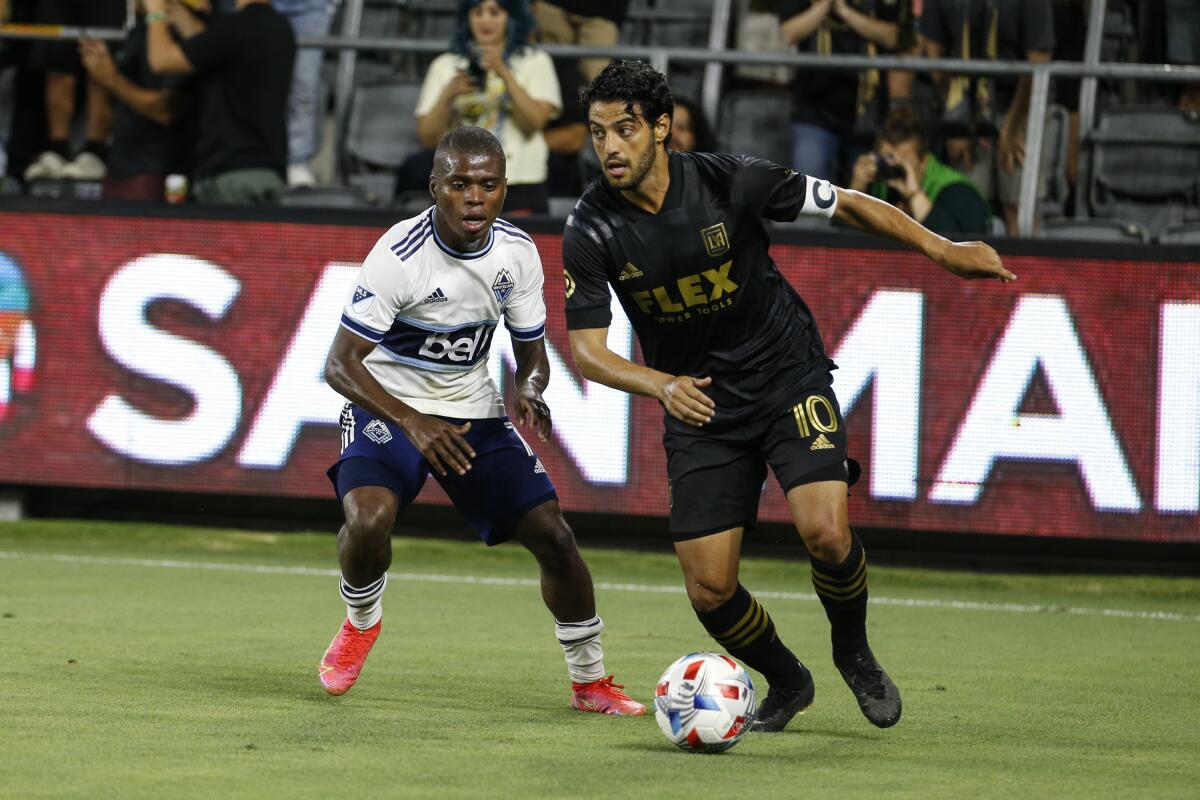
LAFC has been even more confounding. Three seasons after breaking the MLS record for points and tying the record for goals with 85, Bob Bradley’s team is fifth in the West and hasn’t scored more than two goals in any game this season. LAFC would be higher in the standings, but four times it has conceded goals after the 86th minute, costing it two wins and two draws.
If the Galaxy are treading water, LAFC at least appears to be making halting progress. It lost just once in July and Vela, who had scored just four times in his previous 15 games, now has scored in four consecutive games.
Help is on the way for LAFC, too. The team on Monday announced its acquisition of forward Cristian Arango from Colombia’s Millonarios on a reported $2.5-million transfer. Arango, 26, scored 22 times in 58 appearances for Bogota-based Millonarios. With LAFC he is expected to play as a center forward between Vela and Diego Rossi and fill the void created when the team declined a contract option on Bradley Wright-Phillips last fall.
That transaction is the third the team has made in the last week, following the trades of midfielder Mark-Anthony Kaye and Corey Baird to the Colorado Rapids and Houston Dynamo, respectively. The trades netted LAFC $1.75 million in general allocation money and a pair of 2022 international roster slots.
LAFC, which has played to draws in its last two matches, will host second-place Sporting Kansas City on Wednesday.
And finally there’s this …
Patrick Mahomes, the Super Bowl MVP quarterback of the Kansas City Chiefs, has joined the ownership group of Sporting Kansas City. Mahomes and his finance, Brittany Matthews, a former professional soccer player, also are co-owners of the Kansas City’s NWSL team … The Galaxy have loaned defender Giancarlo González to Alajuelense of the Costa Rican first division in what may be a precursor to the long-rumored arrival of Joveljić. The departure of González, who hasn’t played an MLS minute this season, opens an international roster spot and presumably clears some room under the league salary cap. González is guaranteed more than $918,500 in 2021 according to figures provided by the MLS players association … Major League Soccer’s three Canadian clubs have been cleared to play at home again for the first time in nearly a year. Because of COVID-19 restrictions that had closed the U.S.-Canadian border, the Vancouver Whitecaps have been playing in Sandy, Utah, where they went 3-3-2 while Toronto and Montreal were in Florida. Toronto went 1-2-4 “at home” in Orlando and Montreal was 4-1-2 in Ft. Lauderdale. ... The Galaxy will unveil a statue of Landon Donovan outside Dignity Health Sports Park, honoring the former player for his contributions to the club.
Quotebook
“Football always needs joy. That’s when the game is really played at its best. I feel like we haven’t been able to do that; everything has just been a little bit of a struggle. I certainly love playing with a big smile on my face much more than the opposite. I think everybody else does as well.”
USWNT forward Megan Rapinoe on team’s struggle in the Olympic Games. The U.S. will play for the bronze medal Thursday.
Until next time...
Stay tuned for future newsletters. Subscribe here, and I’ll come right to your inbox. Something else you’d like to see? Email me. Or follow me on Twitter: @kbaxter11.




